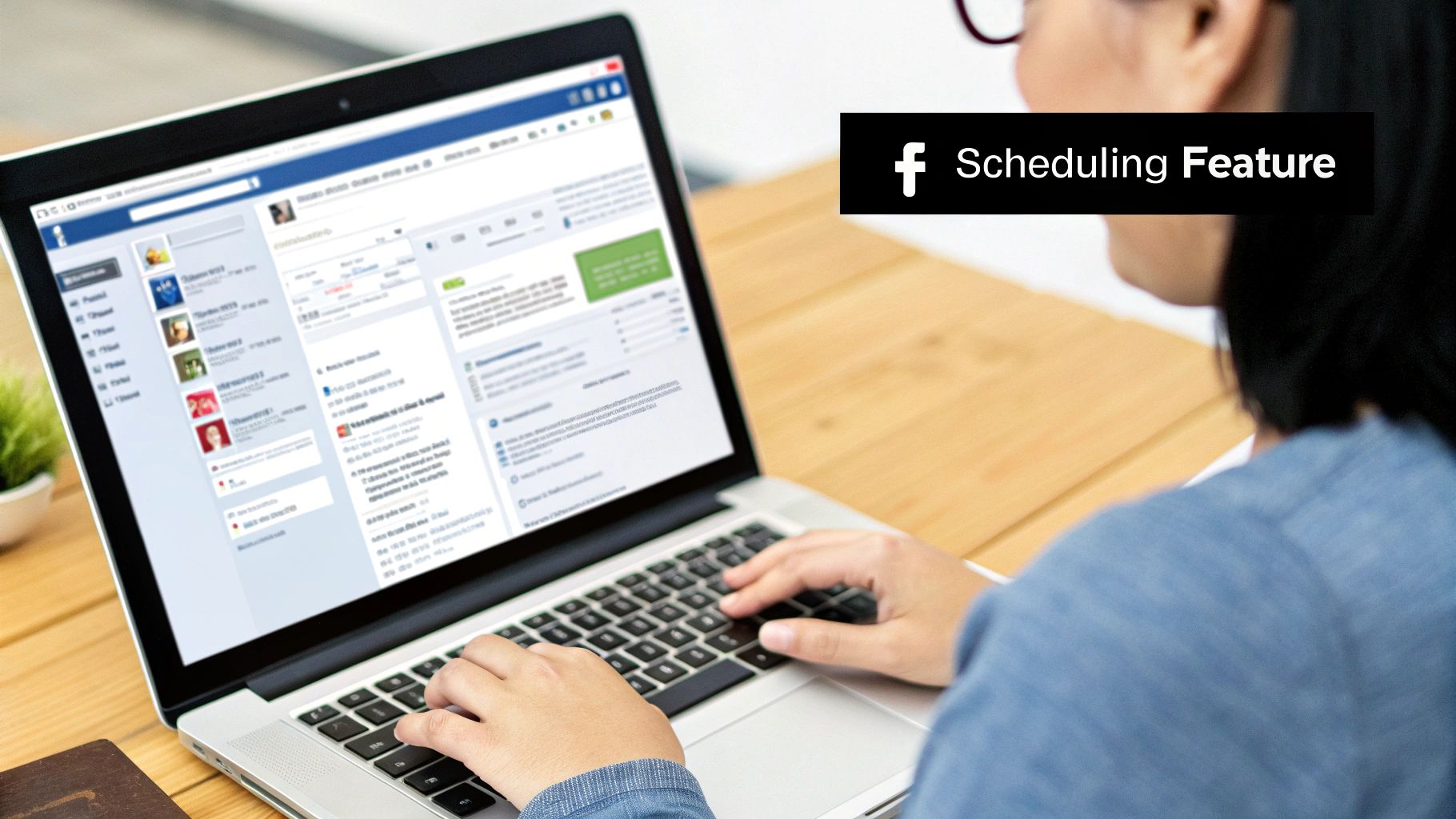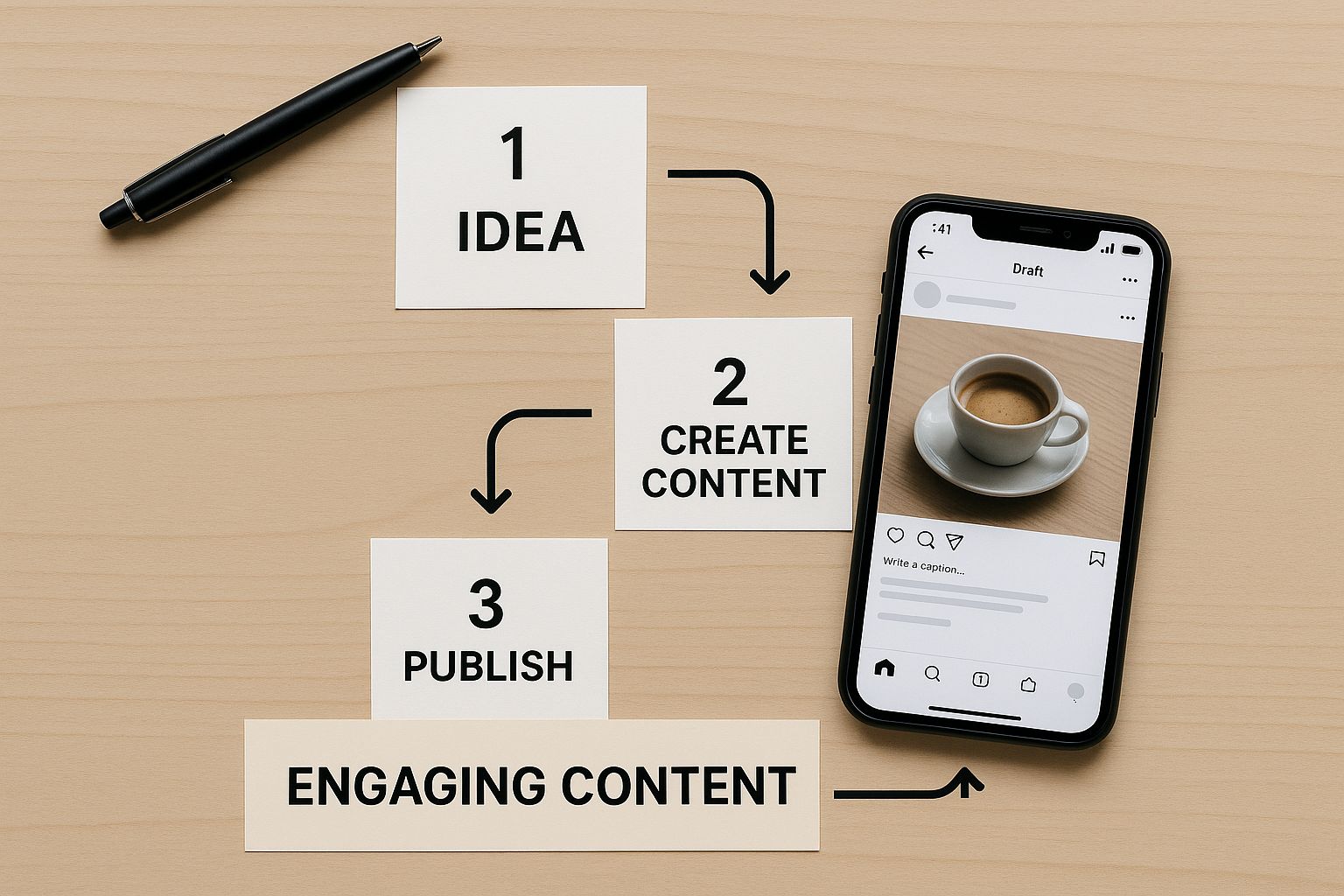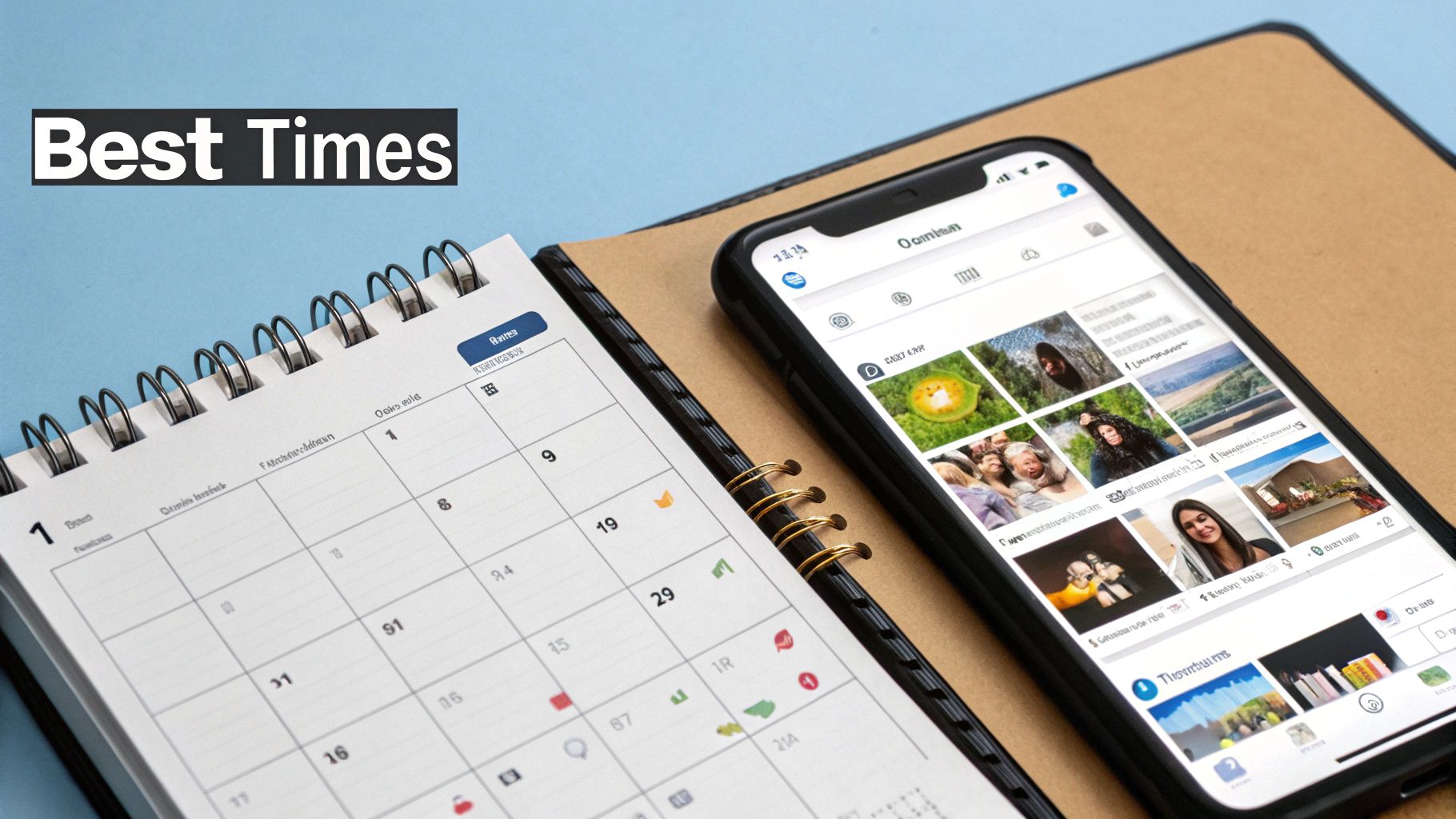Sure, you can always schedule a Facebook post using the native Meta Business Suite or a dozen other third-party tools. But if you're a developer, you know the real power lies in doing it programmatically. Using a unified API like LATE lets you build scheduling features right into your own apps, automate entire content workflows, and manage a ton of accounts without ever touching a UI.
This is the secret sauce for integrating social media into SaaS platforms, custom CRMs, or any content management system you've built.
Why Bother Automating Facebook Posts with an API?
Let's be honest: for any serious developer or marketing team, manually scheduling posts is a soul-crushing, time-sucking task that just doesn't scale. The Meta Business Suite works fine for a single brand, but it quickly becomes a bottleneck when you're juggling multiple client accounts or trying to weave posting into a larger application's logic.
This is exactly where programmatic scheduling changes the game.
When you use an API, you're no longer constrained by a graphical interface. Instead of clicking through a maze of menus, you're just sending a simple HTTP request. That one change opens up a whole new world of automation and efficiency.
Unlock Real Efficiency and Scale
Imagine you're building a SaaS product and want to let your users connect their own Facebook Pages. An API is what makes in-app scheduling possible, creating a smooth, integrated experience. You could build content queues, set up complex approval workflows, or even trigger posts based on other events in your app—all programmatically.
This level of automation brings some huge wins:
- Consistency: Keep a steady flow of content going out without daily manual work. This is absolutely critical for keeping your audience engaged.
- Scalability: Effortlessly manage hundreds—or even thousands—of Facebook Pages from one central system.
- Integration: Bake social media posting directly into the tools you already use, from internal dashboards to your company's CRM.
The business case for API-driven scheduling is pretty straightforward: it frees up precious time for both developers and marketers. You get to shift resources from boring, repetitive tasks to the strategic work that actually drives growth.
And we all know timing is everything on social media. A Sprout Social analysis of nearly 2.5 billion engagements found that the best times to post on Facebook are weekday mornings, usually from 8 AM to noon. An API lets you precisely hit these high-engagement windows across different time zones, automatically. You can read the full analysis of Facebook engagement trends for more detail.
At the end of the day, using a unified API like LATE to schedule a Facebook post isn't just about making things automatic; it's about building smarter, more flexible, and more scalable software.
Getting Your Environment Ready

Before we can start programmatically scheduling Facebook posts, we need to get our house in order. A little prep work now ensures your API calls are authenticated correctly and structured properly, saving you from a lot of head-scratching and common errors down the line.
First things first, you'll need your unique API key from the LATE developer dashboard. This key is your main authenticator, so treat it like a password for your app. Definitely don't hard-code it or let it sneak into a public GitHub repo.
Configuring Your Workspace
With your key in hand, it's time to prep your local environment. While the LATE API is language-agnostic, you can make your life a lot easier by using a library to handle the HTTP requests.
For example, if you're a Python dev, you’ll want to have the requests library installed. If you're in the Node.js camp, something like axios is the go-to for most of us. The main goal here is to have a solid way to send POST requests with the right headers and a JSON body.
Your basic setup checklist should look something like this:
- A secure spot for your API key, like an environment variable.
- A stable version of your language (think Python 3.8+ or Node.js 16+).
- A library for making HTTP requests (
requests,axios, etc.).
Pro Tip: Seriously, use environment variables for your API key (e.g.,
process.env.LATE_API_KEY). It's a best practice for a reason—it keeps your credentials out of your codebase and makes managing them across dev and production a breeze.
Nailing these initial steps creates a solid foundation. If you want a deeper dive, check out our full guide to programmatically schedule a Facebook post.
Now that your credentials are secure and your environment is ready, you're all set to build your first API call and start automating your social media workflow.
Alright, you've got your environment set up. Now for the fun part: turning your idea into a real, scheduled post.
We're going to build a complete API request from the ground up to show you exactly how to programmatically schedule a Facebook post with the LATE API. I'll be using Python and the popular requests library for this walkthrough, but the core concepts are universal, so you can easily adapt them to your favorite language.
The whole process boils down to a single POST request. You'll send it to a specific API endpoint, packed with all the details Facebook needs to publish your content at the exact moment you want.
Breaking Down the API Request
Every successful scheduling request has a few key components that have to work together perfectly. You've got the endpoint URL, the authentication headers to prove it's you, and the JSON payload—the heart of the request, containing your post's content and schedule.
I like to think of it like sending a package. The endpoint is the address, the headers are the mailing labels, and the payload is what's actually inside the box. Get any part wrong, and your post isn't going anywhere.
This infographic lays out the entire journey, from your draft to seeing it live on your Facebook Page.

It’s a great visual reminder of how one simple API call kicks off a whole workflow, turning your raw text and media into something your audience will see.
Constructing the Payload
The most critical piece of this puzzle is the JSON payload. This is where you define everything: the post's message, which Facebook Page it's for, and the precise publication time. The scheduled_at parameter is especially important here.
To avoid any confusion with time zones, the LATE API requires this timestamp to be in ISO 8601 format. A perfect example is
2025-10-26T10:00:00Z. This standard format removes all ambiguity, ensuring your post goes live exactly when you intend.
Let's look at a real-world Python example. In this snippet, we're building the payload from scratch and sending the request to schedule a Facebook post for a future date.
import requests import os
Grab your LATE API key from an environment variable
api_key = os.getenv("LATE_API_KEY")
The endpoint for scheduling all posts
url = "https://api.getlate.dev/v1/posts"
The JSON payload with all your post details
payload = { "text": "Excited to announce our new product feature launching next week! #NewFeature", "social_network_key": "your_facebook_page_key_from_late", "scheduled_at": "2025-10-26T14:30:00Z" }
The all-important authentication header
headers = { "Authorization": f"Bearer {api_key}", "Content-Type": "application/json" }
Time to send the POST request
response = requests.post(url, json=payload, headers=headers)
Let's see what the API said back
print(response.json())
This code is a complete, working model. Just swap in your own API key, the specific Page ID you got from LATE, and your content, and you can run it directly to schedule your first Facebook post through the API. Easy as that.
Handling API Responses Like a Pro

Sending the API request is only half the job. A truly resilient application knows how to interpret what the server says back, whether it's good news or bad. This is what separates a brittle script from a production-ready scheduling system.
After you programmatically schedule a Facebook post, you need to parse the JSON response from the LATE API. A successful call doesn't just disappear into the void; it returns valuable information you can use right away.
Decoding a Successful Response
When your post is successfully accepted, the API will return a 201 Created status code. That's your green light, confirming everything went according to plan. The response body itself will contain some crucial data, most importantly the post_id.
Think of this ID as your digital receipt. You should immediately store it in your database and link it to the content you just scheduled. This ID is your key to managing that post later—whether you need to verify its status, update its content, or cancel it before it goes live.
For instance, a typical success response will look something like this:
{ "status": "success", "data": { "post_id": "pst_1a2b3c4d5e6f7g8h", "scheduled_at": "2025-10-26T14:30:00Z", "status_message": "Post scheduled successfully." } }
Troubleshooting Common API Errors
Of course, things don't always go perfectly. You need to build logic to handle common HTTP error codes gracefully. From my experience, you'll run into these most often:
- 400 Bad Request: This usually means there's an issue with your JSON payload. Double-check for missing required fields, incorrect data types, or a malformed
scheduled_attimestamp. It happens to the best of us. - 401 Unauthorized: Your API key is either missing, invalid, or has expired. Time to generate a new one.
- 403 Forbidden: The API key is valid, but you don't have permission to post to the specified Facebook Page. This often happens if the Page's connection to LATE needs to be refreshed on their end.
Parsing the error message in the response body is key. It often contains a human-readable explanation that can point you directly to the source of the problem, saving you tons of debugging time.
Taking Your Scheduling Engine to the Next Level
Alright, so you've nailed scheduling a basic text post. That’s a solid foundation. But to build a truly robust social media engine, you need to think beyond simple text. The real power comes from handling rich media, catering to a global audience, and writing code that doesn't fall over when an API inevitably acts up.
Let's start with the fun stuff: visuals. A common next step is to schedule a Facebook post with images or video. With the LATE API, this is surprisingly easy. You just add a media_urls array to your JSON payload with links to your publicly hosted assets. That one small change transforms a plain text update into something people will actually stop scrolling for.
Optimizing for Time Zones and Peak Engagement
If your app serves users across the globe, hardcoding a single posting time is a surefire way to get abysmal engagement. Your content needs to show up when people are actually awake and scrolling.
A smart way I’ve seen this handled is by storing time zone preferences for each user or page right in your database. When it's time to schedule, your code can dynamically calculate the correct ISO 8601 timestamp based on that user's setting. This ensures a post scheduled for "9 AM" lands at 9 AM in London for one user and 9 AM in Tokyo for another. Simple, but incredibly effective.
Don't just guess on timing, either. The data is clear. A recent analysis from HubSpot, for example, shows the hours between 7 a.m. and 9 a.m. are golden for Facebook engagement worldwide. You can dig into their 2025 social media report for more platform-specific insights to really dial in your strategy.
Building a Resilient, Production-Ready System
Finally, let's talk about reality. Production-level code has to be ready for anything. Every API has rate limits, and network hiccups are just a fact of life. You need to build resilience directly into your scheduling logic. I’m a big fan of using automated retries with an exponential backoff strategy for those temporary, transient errors.
Logging is your absolute best friend here. Seriously. If a post fails to schedule after a few retries, log the entire failed request payload and the exact error response from the API. This creates an invaluable debugging trail so you can fix issues without bringing the whole system to a halt.
Once you combine media handling, intelligent time zone management, and robust error resilience, you've moved from a simple script to a powerful, professional-grade scheduling system. For more ideas on how to scale your automation even further, check out our guide on how to schedule social media posts the smart way.
Answering Common Developer Questions
Even with an API as straightforward as ours, you’re bound to have questions when you first start to schedule a Facebook post programmatically. I’ve seen developers run into the same handful of issues, so let’s get ahead of them.
Here are a few quick answers to the most common questions we see.
Common Developer Questions
We've compiled a quick reference table to address the most frequent queries developers have when integrating with the LATE API for Facebook scheduling.
| Question | Answer |
|---|---|
| How do I handle expiring access tokens? | The best approach is to build a proactive refresh mechanism. Before making a batch of API calls, check if the token is close to expiring and refresh it. This prevents 401 Unauthorized errors and failed posts. |
| Can I schedule more than just text? | Absolutely. You can schedule images, videos, and link previews. Just include the media_urls in your payload for images/videos, or a URL in the text for a link preview. |
| What happens if a post fails to schedule? | The API will return a specific error code. Your code should catch these errors and implement a retry logic, especially for temporary network issues or platform-side glitches. |
| How do I manage rate limits? | Monitor the X-RateLimit-Remaining header in the API response. If it gets low, slow down your requests. Implement an exponential backoff strategy if you receive a 429 Too Many Requests error. |
Getting these small details right from the start will save you a ton of headaches down the road and lead to a much more resilient integration.
What's the Right Way to Handle Access Tokens?
Authentication is almost always the first hurdle. Your access token is the key to everything, but it's not permanent. Tokens expire, and they can be revoked, which is when you'll start seeing those dreaded 401 Unauthorized errors.
My best advice? Don't wait for your API calls to fail. Build a small, proactive mechanism that checks your token's validity before you make a batch of requests. If it's nearing its expiration, refresh it automatically.
This simple, proactive step is the difference between a smooth, reliable application and one that causes frantic, late-night debugging sessions when posts suddenly stop going out.
Can I Schedule Different Media Types?
Of course! A common misconception is that programmatic scheduling is just for plain text. That might have been true years ago, but modern unified APIs like LATE are designed for the visual web. After all, what’s Facebook without images and videos?
You can easily schedule rich media by defining it in your API payload. It’s pretty intuitive:
- Images: Just include a direct URL to your hosted image file in the
media_urlsarray. - Videos: It works the same way—provide a URL to a video file, and the API handles the rest to ensure it plays natively on Facebook.
- Link Previews: There's usually no special field for this. Simply dropping a URL into the
textfield will trigger Facebook to generate its standard link preview.
This flexibility means you don't have to compromise on your content strategy. If you want to dive deeper into building out these kinds_of workflows, we cover more ground on automated social media posting in another one of our guides.
Ready to stop juggling multiple social media APIs? With LATE, you can integrate once and schedule posts across seven platforms with a single, reliable endpoint. Start building for free at https://getlate.dev.